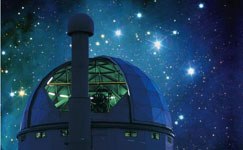SALT benefits small South African town
4 June 2015
The Southern African Large Telescope (SALT) has placed South Africa and the
continent on the global science map, but there have also been collateral benefits.
The tiny town of Sutherland had been stagnant in terms of socio-economic
development before the construction of SALT, explained Sivuyile Manxoyi, from the
South African Astronomy Observatory (SAAO). Following the construction of the
telescope, the town had gone from having two bed-and-breakfast establishments to
having more than 40 options for accommodation.
Manxoyi was speaking at the five-day SALT conference, taking place at Stellenbosch
University until 5 June. The event was opened by Science and Technology Minister
Naledi Pandor.
"Sutherland has become a tourist destination, something that would have been
unheard of before SALT," Manxoyi said. "Now, between 10 000 and 12 000 tourists
visit the area every year."
More importantly, SALT had presented an
ideal opportunity to promote astronomy,
mathematics, physical science and chemistry as subjects for study and career
options. Manxoyi said the SAAO was providing guidance to teachers all over the
country on the teaching of astronomy and building enthusiasm for mathematics and
science.
The observatory was also interacting with thousands of pupils, taking them to
observatories and involving them in science clubs and star-gazing events. Through
creating awareness about astronomy, the future of the impoverished region would
be vastly improved.
Speaking earlier at the conference, Pandor said astronomical sciences were an
important facet of South Africa's strategy for research, development and innovation,
and that astronomy partnerships presented unique and invaluable opportunities.
"Such partnerships build infrastructure for astronomy and for wider use.
"Big telescopes require high-speed research networks and computing resources,
which, in turn,
enable our life and climate scientists to share and analyse huge data
sets – a precondition for the development of new drugs and vaccines – as well as
effectively combating and adapting to climate change."
Astronomy partnerships had also helped to popularise the study of astronomy in
Africa and further afield. "As a result of the various human capital development
programmes associated with Africa's SKA [Square Kilometre Array] initiatives, new
astronomy programmes have been established at several African universities,
including in Kenya, Madagascar and Mozambique," the minister said.
"Under other programmes, several postgraduate students from Africa are studying
at European universities, contributing to Europe's knowledge generation, while
leading European and American astronomers have taken up positions in Africa, for
example through the South African Research Chairs Initiative."
She said astronomy was expanding Africa's future workforce of
scientists and
engineers. "South Africa pursued the SKA project by using the lessons learned from
SALT as the basis for our planning and partnerships. The links we developed
through the SALT project allowed us to build on existing networks and partnerships
to secure the iconic SKA, an extremely important strategic initiative that puts
science and technology to work for the benefit of all Africans."
SALT has been available to scientists since 2012. By the end of April this year, it
had produced 109 papers based on SALT observations. The paper on the discovery
of the first-known stars in the Milky Way galaxy was published in the prestigious
Nature journal. These stars are situated on the far side of the galaxy, 80 000 light
years from Earth.
"Our aim is to position Africa as a global centre of research excellence for
multiwavelength astronomy, with optical, radio and gamma-ray telescopes working
together to achieve common scientific goals," Pandor
said.
"We need to do more to build bridges across the multiwavelength spectrum, but it is
encouraging to see positive developments in this regard, for example, the
MeerLICHT, a partnership between the South African, Dutch and British astronomy
communities."
MeerLICHT aims to provide a real-time optical view of the radio-transient sky. It
will receive its input from the MeerKAT operators in Cape Town so that
simultaneous optical and radio data can be obtained.
Source: Department of
Science and Technology
 South Africa's Southern African Large Telescope (SALT) is the largest single optical telescope in the southern hemisphere (Image: SALT)
South Africa's Southern African Large Telescope (SALT) is the largest single optical telescope in the southern hemisphere (Image: SALT)




